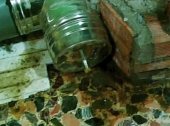


Rocket Mass Heater Plans: Annex 6" L-shaped Bench by Ernie and Erica
will be released to subscribers in:
soon!











Success has a Thousand Fathers , Failure is an Orphan
LOOK AT THE " SIMILAR THREADS " BELOW !
 1
1




















Success has a Thousand Fathers , Failure is an Orphan
LOOK AT THE " SIMILAR THREADS " BELOW !










Success has a Thousand Fathers , Failure is an Orphan
LOOK AT THE " SIMILAR THREADS " BELOW !




Jay C. White Cloud wrote:Hello Jay,
You project and goals sound interesting and generally very achievable. I would suggest have a read through some of the information in this link about Ondol:
 1
1





I will modify my position on vapor barriers under concrete slabs to say that If there are any suspected drainage issues they should be addressed first, Next I would roughly level the site and haul in crusher run Gravel to raise the base of my pour above grade , and then belt and suspenders, add a vapor barrier, in this case the Hydrophilic properties of concrete are well known, but specifically in this case an elevated base and a vapor barrier would tend to promote a dryer soil due to the creation of an Umbrella effect, reducing loss of heat energy and adding insulation.

I most often tell everyone to plan on a final vertical chimney that exceeds the minimum of breaking the plan of the roof, I have seen detached chimneys work
well in more than one location often superiorly ones that were sited in june disregarding unknown weather conditions in Jan Feb,
I will pick my battles carefully with regard to chimney height! But do want to point out that your portfolio of photographs are likely to favor builds who know how
to site and build chimneys in harmony with local weather patterns !

|
I'm just a poor boy, I need no sympathy, because I'm easy come, easy go, little high, little low, little ad
Learn Permaculture through a little hard work
https://wheaton-labs.com/bootcamp
|








